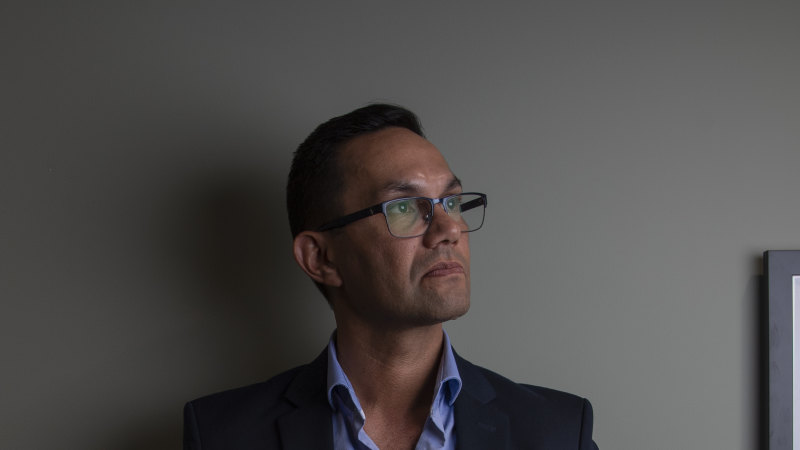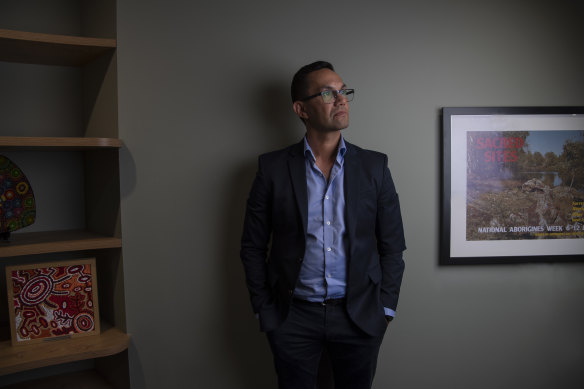Save articles for later
Add articles to your saved list and come back to them any time.
Federal agencies need an Indigenous Voice to get better results from new spending on basic services, according to a new report that rejects “mistruths” about $40 billion in annual outlays.
In a strong call for better consultation on how to spend the money, the Lowitja Institute warns that health and other measures have not improved because there is no mechanism like the Indigenous Voice to help advise on spending.
The findings from the Lowitja Institute, a national indigenous health research group based in Melbourne, counter a growing series of false claims in the mainstream media and on social media that Indigenous Australians receive $40 billion a year from taxpayers.
Selwyn Button, chairman of the Lowitja Institute. Credit: Louise Kennerley
Lowitja Institute chairman Selwyn Button, a Gungarri man who is also partner of both PwC Australia and PwC Indigenous Consulting, said the spending claims had turned into one of the “biggest mistruths” of the campaign about the Indigenous Voice.
“The core of the mistruth is how much control and influence Indigenous people have, and how much money goes directly to Aboriginal and Torres Strait Islander people,” he said.
“The analysis shows how much of this money they actually control and influence – and it’s a very small proportion.”
Button said 86 per cent of the spending said to go to Indigenous Australians was going towards “indirect government services” received by all members of the community, such as public schools, hospitals, aged care facilities and prisons.
The health spending reflected poor health outcomes for Indigenous Australians and therefore their greater need for services at local hospitals, sometimes in remote locations that are more expensive to operate than city facilities.
In prisons, the results reflected higher incarceration rates for Indigenous Australians.
Disputes over the spending have intensified since Kamahl, a singer and musician, appeared on the Ten’s The Project last Sunday night and said he opposed the Voice, claiming in the interview that $40 billion was spent on Indigenous people every year.
Sky News host Peta Credlin has also estimated the spending at $40 billion, backing Kamahl, after citing estimates from the Productivity Commission.
The Productivity Commission report shows the spending was $33.4 billion in 2016 across all services from federal, state and territory governments. The federal portion was $14.7 billion.
The Institute of Public Affairs, a conservative group, estimated this week that the $33.4 billion would have risen to $39.5 billion this year on the assumption it increased in line with inflation. There is no update from the Productivity Commission to determine whether the IPA calculation is accurate.
The official ‘No’ pamphlet lists the risks of rising costs and bureaucracy as one of its 10 reasons to reject the amendment, while independent senator Lidia Thorpe also says the Voice will be “a waste of money”.
Button said the key issue was the high proportion of the spending that went to services outside the control of Indigenous people, with the 86 per cent figure likely to apply whether the total was $33.4 billion or $39.5 billion.
“It matters because it shows that the Voice is required to influence how that money is spent,” he said.
“It shows that, at the moment, community-controlled organisations and Indigenous communities are fighting over scraps. We should be having a conversation about how to use the larger spend to get better outcomes.”
In a key finding, the report checks the outcomes on the national “closing the gap” strategy to conclude that additional spending has not led to better outcomes on measures such as health.
“Federal expenditure on Indigenous-specific functions has doubled over the last 15 years, but outcomes have not improved at a corresponding rate,” it says.
“In the last five years, successive Australian governments have announced more than $2.7 billion in new money toward closing the gap initiatives. However, the latest closing the gap data shows that many key outcomes and indicators for Aboriginal and Torres Strait Islander peoples are not on track, and in some areas are getting worse.”
The report concludes that the Indigenous Voice would be a “robust external mechanism” to assess whether the spending was being put to good use and tell political leaders if they needed to make changes to get a better return on investment.
Cut through the noise of federal politics with news, views and expert analysis. Subscribers can sign up to our weekly Inside Politics newsletter.
Most Viewed in Politics
From our partners
Source: Read Full Article


